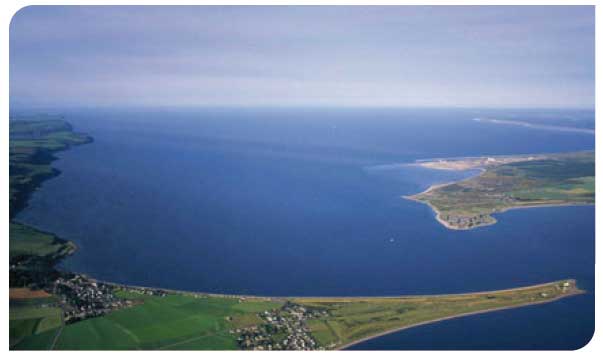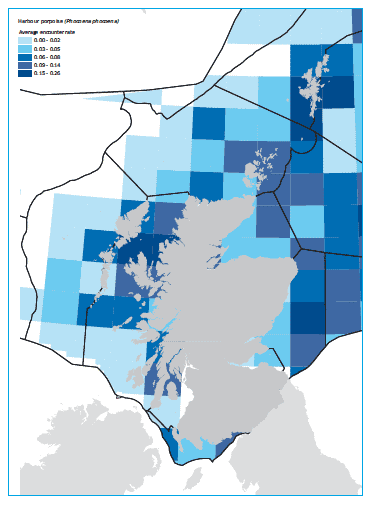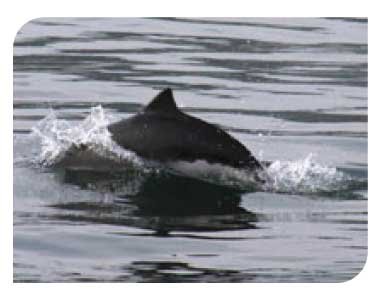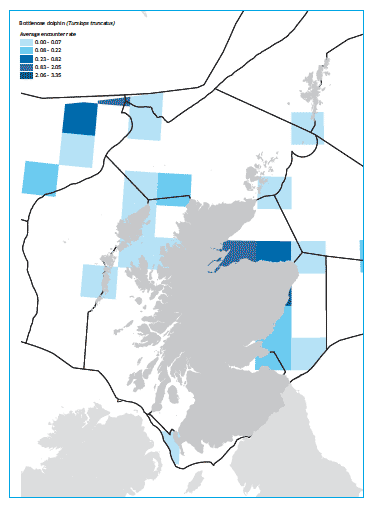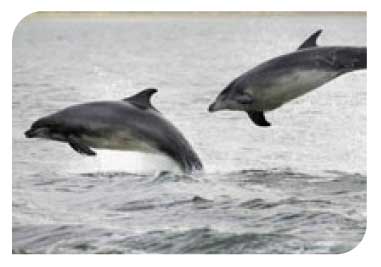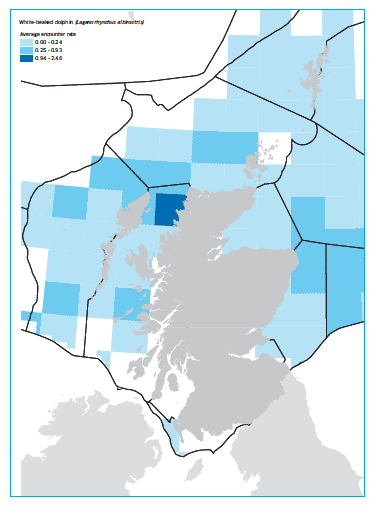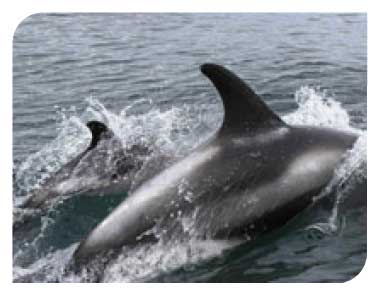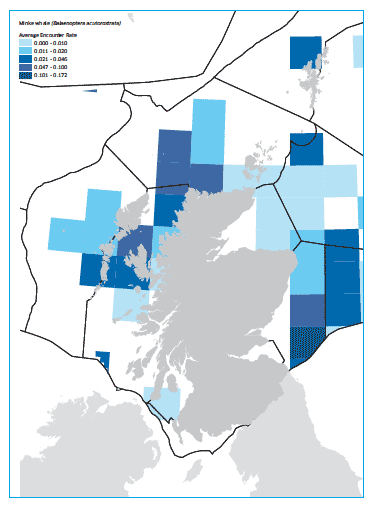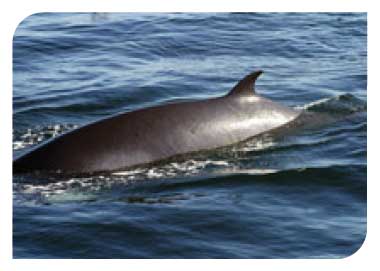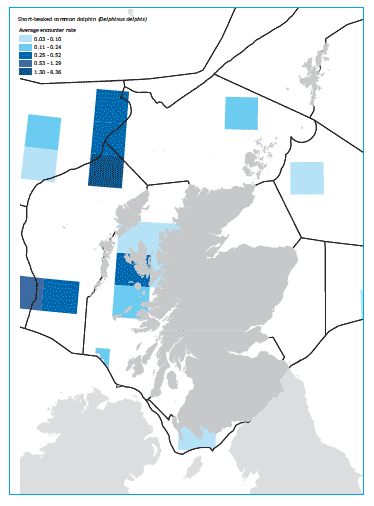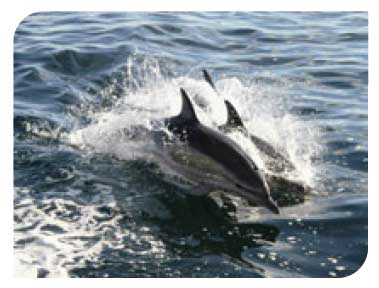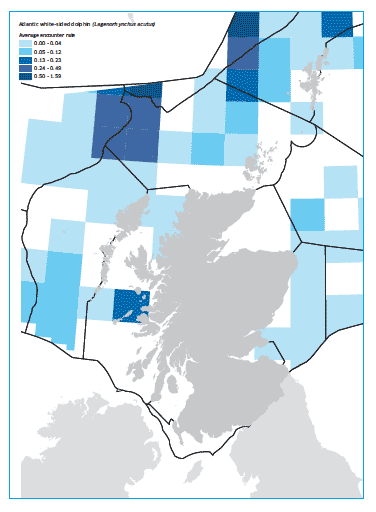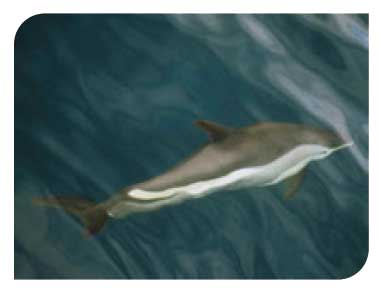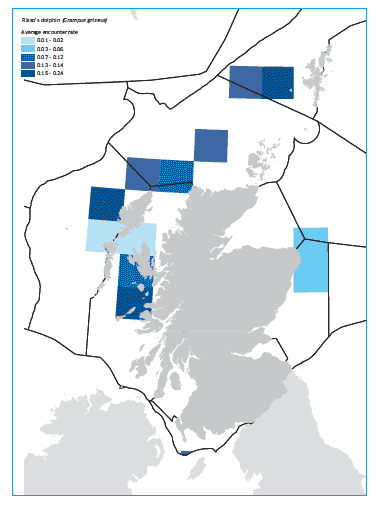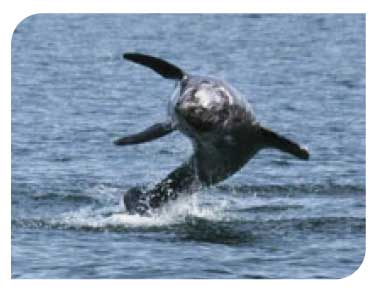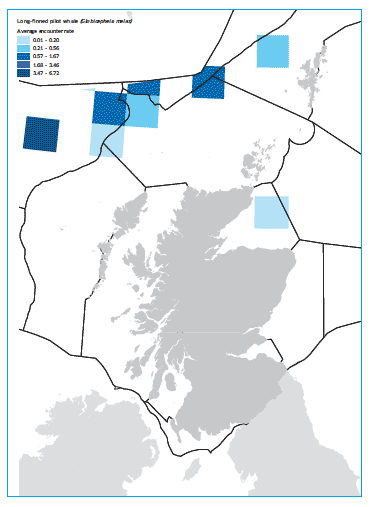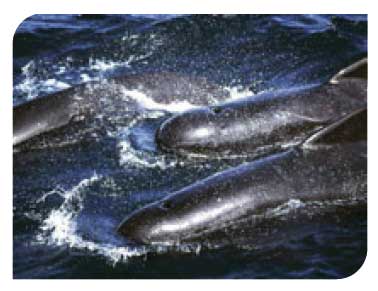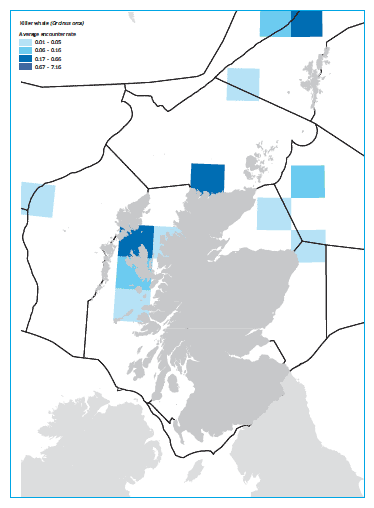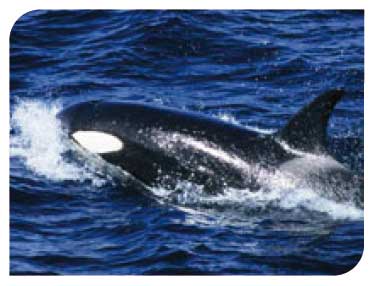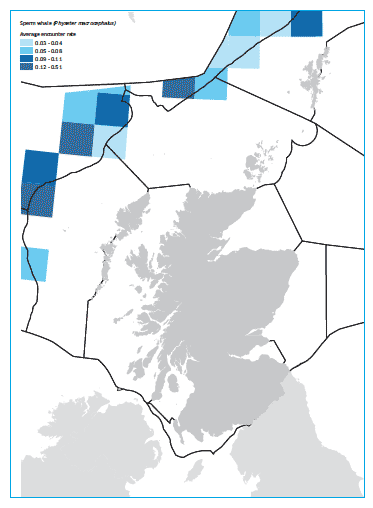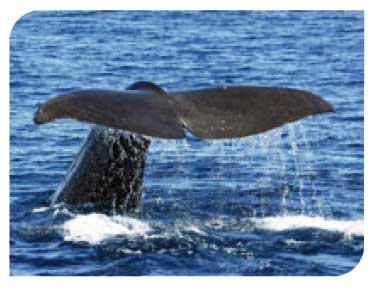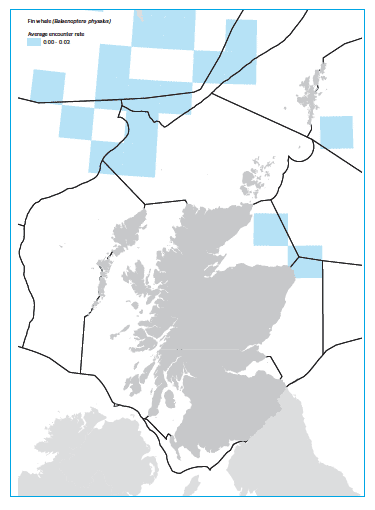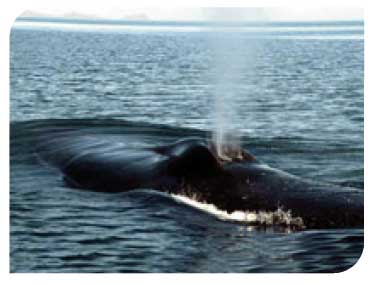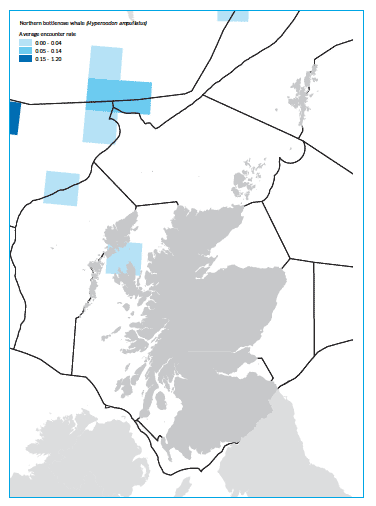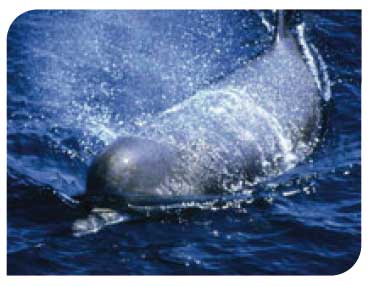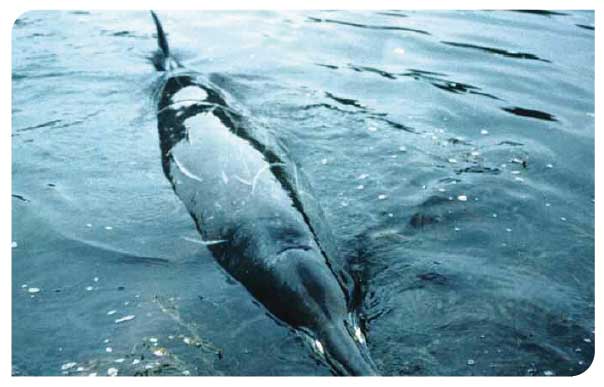Scotland's Marine Atlas: Information for The National Marine Plan
Scotland's Marine Atlas is an assessment of the condition of Scotland's seas, based on scientific evidence from data and analysis and supported by expert judgement.
CETACEANS
Whales, dolphins and porpoises are collectively known as cetaceans. Twenty-three species have been recorded in Scottish waters over the last 25 years. Of these 11 are regularly sighted, the remaining 12 are considered to be vagrants or rare visitors.
Cetaceans are very mobile and can range widely with some undertaking large scale seasonal migrations often leaving Scottish waters in the process. Other species are more localised in their distribution. The greatest diversity of species is found off the continental shelf in waters to the north and west of Scotland.
Legislation
Cetaceans are protected by a number of international conventions and agreements. All cetacean species are listed on Annex IV of the Council Directive 92/43/ EEC of 21 May 1992, commonly known as the Habitats Directive, 'animal and plant species of community interest in need of strict protection'. Two species (bottlenose dolphin and harbour porpoise) are also listed on Annex II 'whose conservation requires the designation of Special Areas of Conservation'. At present there is one SAC designated for the bottlenose dolphin in Scotland but none for the harbour porpoise.
Further obligations under the Habitats Directive require the UK'to maintain or restore, at favourable conservation status, natural habitats and species of wild fauna and flora of Community interest'and ' establish a system to monitor the incidental capture and killing of the animals species listed in Annex IVa. In the light of the information gathered, Member states shall take further research of conservation measures as required to ensure that incidental capture and killing does not have a significant negative impact on the species concerned.'and under the Agreement on the Conservation of Small Cetaceans in the Baltic and North Sea ( ASCOBANS) the UK is required to ' endeavour to establish an efficient system for reporting and retrieving bycatches and stranding specimens and to carry out … full autopsies in order to collect tissues for further studies and reveal possible causes of death'.
Pressures
Cetaceans face a number of threats such as noise disturbance from shipping, oil and gas operations, military activities and potentially from other novel activities such as renewable energy developments. They are also vulnerable to pollution although concentrations of many contaminants such as PCBs are declining. Bycatch is the main form of direct human-caused mortality in UK waters. It is seen as a particular threat to harbour porpoises and short-beaked common dolphins although with the reduction in the use of static fishing gear this is declining. Council Regulation 812/2004 lays down measures concerning incidental catches of cetaceans by fisheries and requires member states to report certain cetacean bycatch.
Some species are at risk from entanglement and of death or injury from collisions with vessels. At present this is considered to be slight but with the installation of new renewable energy devices it is possible that this risk could increase. It is not known what the likely impacts of wide scale habitat damage/change are, nor the implications of climate change for cetaceans.
Distribution of cetacean species occurring in Scottish waters
(Species with an asterisk are Priority Marine Features)
Species |
UK continental shelf ( CS) |
UK offshore waters ( OS) |
Population estimates |
Date of estimate |
|---|---|---|---|---|
Phocoena phocoena* |
v |
385,600 |
2005 |
|
Tursiops truncatus* |
v |
v |
12,600 |
2005 CS |
Lagenorhynchus albirostris* |
v |
22,700 |
2005 |
|
Balaenoptera physalus* |
v |
9,000 |
2007 |
|
Balaenoptera acutorostrata* |
v |
v |
18,600 |
2005 CS |
Delphinus delphis* |
v |
v |
63,400 |
2005 CS |
Lagenorhynchus acutus* |
v (summer only) |
v |
74,600 |
2004 CS |
Grampus griseus* |
v |
No pop. estimate |
||
Globcephala melas* |
v |
25,100 |
2007 |
|
Orcinus orca* |
v |
v |
Widespread but pop. size unknown |
|
Physeter macrocephalus* |
v |
2,100 |
2007 |
|
Stenella coeruleoalba |
v |
67,400 |
2007 |
|
Hyperoodon ampullatus* |
v |
7,000 for all beaked whales |
2007 |
|
Ziphius cavirostris |
v |
7,000 for all beaked whales |
2007 |
|
Mesoplodon bidens* |
v |
7,000 for all beaked whales |
2007 |
|
Mesoplodon mirus |
v |
No data |
||
Balaenoptera borealis |
v |
370 |
2007 |
|
Balaenoptera musculus |
v |
No data |
||
Megaptera novaengliae |
v (summer only) |
v |
No data |
|
Delphinapterus leucas |
v |
No data |
||
Eubalaeana glacialis |
v |
No data |
||
Preudorca crassidens |
v |
No data |
||
Kogia breviceps |
v |
No data |
Priority Marine Features Harbour porpoise (Phocoena phocoena) |
Moray Firth - Bottlenose dolphin Special Area of Conservation
|
|
Harbour porpoise Habitat: Open coast, shallow bays, estuaries and sea lochs Scottish distribution: Abundant in waters all around Scotland Status:IUCN Red List - Least Concern |
|
|
Bottlenose dolphin Habitat: Open coast, sea lochs, firths and offshore Scottish distribution: Resident population of around 111 individuals known from Moray Firth and adjacent coastal waters. Also recorded from around Inner and Outer Hebrides Status:IUCN Red List - Least Concern |
|
|
White-beaked dolphin Habitat: Open coast, sea lochs with a preference for waters shallower than 200m and along the shelf edge Scottish distribution: Abundant in all Scottish waters but concentrated around the Hebrides and Northern Isles Status:IUCN Red List - Least Concern |
|
|
Minke whale Habitat: Open coast, straits and sounds, sea lochs and occasionally offshore Scottish distribution: Throughout Scottish waters Status:IUCN Red List - Least Concern |
|
|
Short-beaked common dolphin Habitat: Open coast, offshore with a preference for areas of steep seabed Scottish distribution: Mainly around the Hebrides Status:IUCN Red List - Least Concern |
|
|
Atlantic white-sided dolphin Habitat: Offshore along the outer continental shelf and slope Scottish distribution: Around the Hebrides, Northern isles and North Sea Status:IUCN Red List - Least Concern |
|
|
Risso's dolphin Habitat: Open coast, straits and sounds, sea lochs and offshore with a preference for areas with steep sloping sea bed Scottish distribution: Most sightings around the Outer Hebrides, occasionally from Northern Isles and off the east coast Status:IUCN Red List - Least Concern |
|
|
Long-finned pilot whale Habitat: Deep waters along and seaward of the continental shelf edge Scottish distribution: Sightings limited to Moray Firth and offshore west of the Hebrides and Shetland Status:IUCN Red List - Data Deficient |
|
|
Killer whale Habitat: Open coast, straits and sounds, sea lochs and offshore Scottish distribution: All around coast but sightings concentrated around Mull, north-east coast and Northern Isles Status:IUCN Red List - Data Deficient |
|
|
Sperm whale Habitat: Continental slope and oceanic waters >1000m deep Scottish distribution: Offshore to north and west of Scotland, occasionally seen inshore off Shetland Status:IUCN Red List - Vulnerable |
|
|
Fin whale Habitat: Deepwater (400-2000m) beyond the edge of the continental shelf where they favour banks, mounds and areas of upwelling and frontal zones Scottish distribution: Beyond the continental shelf margin in northern waters Status:IUCN Red List - Endangered |
|
|
Northern bottlenose whale Habitat: Cold temperate to subarctic deep waters beyond the edge of the continental shelf at depths of between 500-1500m, often near submarine canyons Scottish distribution: Most records from beyond the continental shelf edge to the north-west of Scotland in summer months Status:IUCN Red List - Data Deficient |
|
|
Sowerby's beaked whale Habitat: Occurs almost exclusively in deep waters beyond the continental shelf edge Scottish distribution: Most records are from north-west and east Scotland Status:IUCN Red List - Data Deficient |
|
|
Status
Five species (harbour porpoise, bottlenose dolphin, white-beaked dolphin, fin whale and minke whale) are considered to be in favourable condition, with the status of another six (short-beaked common dolphin, Atlantic white-sided dolphin, Risso's dolphin, long-finned pilot whale, killer whale, sperm whale) unknown because of a lack of suitable abundance estimates. The status of the remaining vagrant and rare species also could not be assessed.
As a group cetaceans are considered to be in good condition in the North Sea, but in moderate condition in the Minches and Western Scottish waters. The status of cetaceans in the Scottish continental shelf and offshore waters is unknown.
Species |
Range |
Population |
Habitat |
Future prospects |
Overall assessment |
|---|---|---|---|---|---|
Harbour porpoise |
favourable |
favourable |
favourable |
favourable |
favourable |
Bottlenose dolphin |
favourable |
favourable |
favourable |
favourable |
favourable |
Minke whale |
favourable |
favourable |
favourable |
favourable |
favourable |
White-beaked dolphin |
favourable |
favourable |
favourable |
favourable |
favourable |
Fin whale |
favourable |
favourable |
favourable |
favourable |
favourable |
Short-beaked common dolphin |
favourable |
unknown |
favourable |
unknown |
unknown |
Atlantic white-sided dolphin |
favourable |
unknown |
favourable |
unknown |
unknown |
Risso's dolphin |
favourable |
unknown |
favourable |
unknown |
unknown |
Killer whale |
favourable |
unknown |
favourable |
unknown |
unknown |
Sperm whale |
favourable |
unknown |
favourable |
unknown |
unknown |
Long-finned pilot whale |
favourable |
unknown |
favourable |
unknown |
unknown |
There is a problem
Thanks for your feedback
